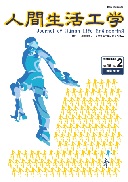All issues

Volume 9 (2008)
- Issue 1 Pages 19-
Volume 9, Issue 1
Displaying 1-2 of 2 articles from this issue
- |<
- <
- 1
- >
- >|
-
Ryoko Fukuda2008 Volume 9 Issue 1 Pages 19-24
Published: 2008
Released on J-STAGE: May 21, 2021
MAGAZINE FREE ACCESSIn aged society, consideration on older drivers will be more important. In order to clarify the needs of current and future older drivers at the point of purchase, evaluation grid method was applied. The results showed that ease of getting on and off a car should be considered and it was already pointed out for a long time. In addition, it was showed that safety, comfort, and confidence, which were related to fundamental aspects of driving, were also important for older drivers. Though normal interview or questionnaire was not powerful enough, evaluation grid method was able to show some aspects of the needs of older drivers. Therefore, this study showed the effectiveness of evaluation grid method to clarify needs of older users and the results can be applied for designing vehicles with consideration on older drivers.View full abstractDownload PDF (3224K) -
- Preliminary Study about Experimental Method for Availability of the System -Hiroaki NAGASE, Junpei AIZAWA, Ryoichi HAYASHI, Shinji OHARA2008 Volume 9 Issue 1 Pages 25-30
Published: 2008
Released on J-STAGE: May 21, 2021
MAGAZINE FREE ACCESSIn order to support the rehabilitation of postural control disorders such as Parkinson 's disease (PD), novel rehabilitation equipment has developed, based on the hypothesis that sinusoidal oscillation (liner and rotary motion) of a platform (seat) in the horizontal plane induces response of the patient's postural control. Then, we examined the evaluation method for availability of this rehabilitation equipment. First, a drive unit of the platform used as the core of this system which could generate sinusoidal oscillation in its platform was developed, and an experimental system incorporating it was built. In this experiment, we compared PD patients with normal subjects. The motion of the trunk of the subject sitting on the equipment platform, subjected to sinusoidal oscillation, was measured by an accelerometer. Result, we found that normal subjects could absorb a perturbation of the trunk by keeping it in antiphase to the platform motion actively. In PD patients, the tendencies which the trunk motions to become larger than platform motion at in–phase were found. Moreover, we analyzed the postural reflex of PD patients under right–and–left liner motion tried before and after rotary motion using video tracking method. Consequently, the inclination of the trunk of “Pisa sign” which had appeared in the liner motion before rotary motion decreased slightly in the liner motion after rotary motion.View full abstractDownload PDF (3878K)
- |<
- <
- 1
- >
- >|